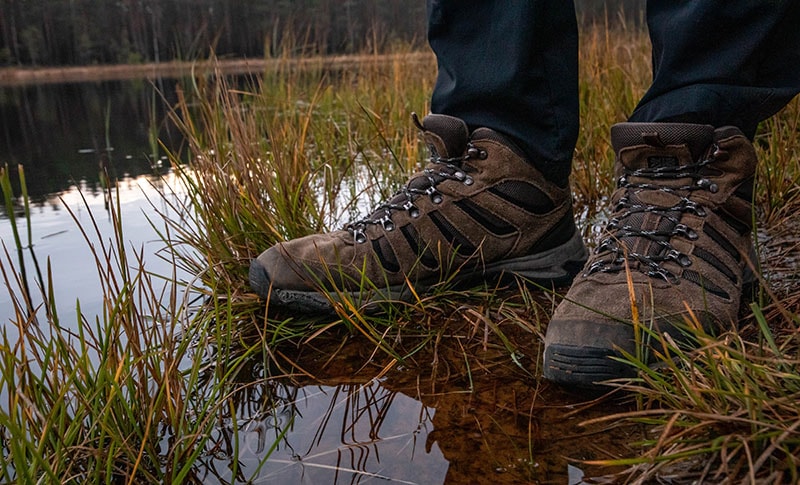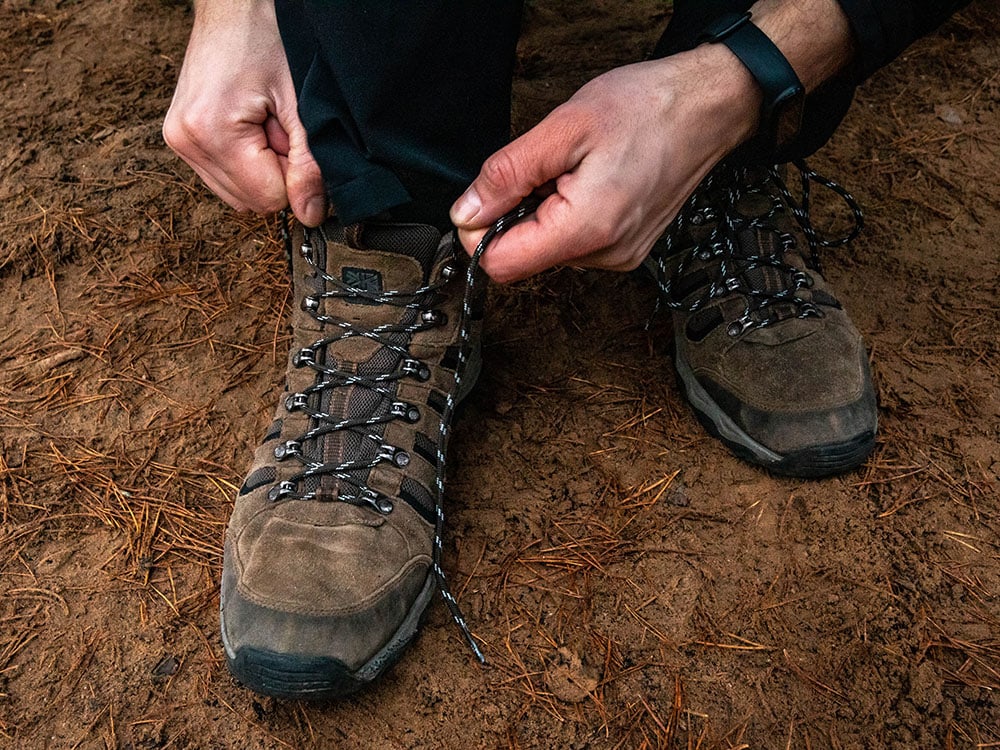If you’d go hiking in a pair of new hiking boots, there’s a high chance that you’d get blisters. So a smarter idea would be to break them in first. This stretches and shapes the boot to fit your feet, which causes you to not get blisters anymore. It’s especially important to do before setting out on longer hikes.
How Long It Takes to Break in Hiking Boots
You can break in your hiking boots in 5 days by walking 15-25 km (9-16 miles) in total without getting any blisters. You have to gradually increase the hiked distance and pack weight over time.
You’d start by walking a very short distance without wearing a backpack and by the end walk a long distance with a heavy pack. If you don’t have a thru-hike coming up and you don’t need to rush anywhere, using this technique is preferable over other ones. It’s easier on your feet and there’s no risk of damaging your hiking boots.
Here’s how to break in your hiking boots in 5 days:
- Day 1: Walk 2-3 km (1-2 miles) with your new pair of hiking boots. Wear good hiking socks and don’t wear a backpack.
- Day 2: Increase the walking distance to 3-5 km (2-3 miles).
- Day 3: Walking the same distance as day 2, add a small 5 kg (11 lbs) backpack.
- Day 4: Same as day 3, but increase the pack weight to 10-15 kg (22-33 lbs).
- Day 5: Walk 5-8 km (3-5 miles) with 10-15 kg (22-33 lbs) on your back. By now you shouldn’t be getting any more blisters from your boots.
Important note: Pay close attention to your feet. If you feel sore spots, tape your feet immediately and stop hiking, otherwise you’ll get blisters. Only increase the distance and pack weight if you aren’t feeling any sore spots. It’s also okay to skip a day or two between hiking.
How to Break in Hiking Boots Fast in 1 Day

You can break in a new pair of hiking boots quickly by soaking them in water and walking them dry. This is a very old and known technique for breaking in old leather hiking boots, but it also works on modern hiking boots.
Here’s how to break in your hiking boots quickly:
- Soak your hiking boots in warm water for 15 minutes. The water shouldn’t be too hot, otherwise it can ruin the glue in your boots. When you put your hand in the water, it should feel a bit warm, but not hot.
- Apply tape to blister-prone areas of your feet. This depends on your feet, but for most people, it’s usually around the pinky and the heel. You need to do this to avoid blisters.
- Put on a pair of dry socks and your wet hiking boots, and go hiking until your boots feel dry. This will shape the padding and the foam inside the boot to the shape of your feet, and cause you to not get blisters anymore.
Important note: I do this technique only if I have a thru-hike coming up very shortly. Otherwise, I prefer the traditional option. That’s because this technique can decrease the lifespan of the hiking boot. If you don’t tape your feet properly, you can also get blisters. So only do it if you’re very limited on time.
You Need to Break in Hiking Boots That Don’t Fit You Perfectly
If you find hiking boots that fit you perfectly in the shop, you don’t need to spend a lot of time breaking them in. When you put them on, they shouldn’t feel too tight around the heel, toes, or any other place, the padding should feel comfortable on your feet, and they shouldn’t move around when walking. They’re already shaped perfectly for your feet, so there won’t be any hot spots, and you won’t get any blisters. Still, it’s a good idea to do a short walk (3-5 km / 2-3 miles) first to make sure that they won’t cause any problems before setting off on a longer hike.
But if you’ve ordered your hiking boots online, and something about them doesn’t feel right, then breaking them in will most likely fix the problem. Just keep in mind that breaking in only fixes minor comfort issues. For example, if your heel feels a bit tight, or the shoe presses a bit against your pinky, then breaking them in will fix it. But if your toes are cramped up or the boot moves around when walking, then you need to get a different model or size.
Summing Up: Breaking In Hiking Boots
Breaking in your hiking boots is something that I recommend doing for anyone who is planning on doing longer hikes over 10 km (6 miles).
I would recommend breaking in your boots by slowly increasing the distance and hiking weight over time. This way, you’re also toughening up your feet, not just the boots themselves, which reduces the chances of getting blisters.
But most importantly, you should get good-fitting hiking boots. You can order them online, but be prepared to return them if they don’t fit perfectly, or try them on in a local store before ordering.
